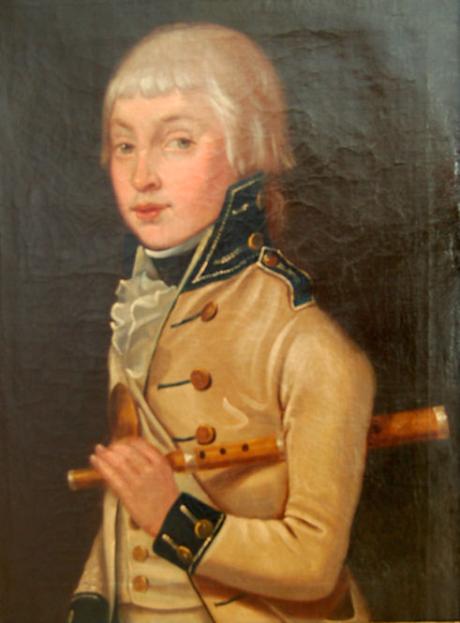( Part of a Pair to the Young Bandsman, Almost certainly brothers
18th c. regimental band uniforms were almost never recorded and information about them is very scarce. Portraits of individual bandsmen from this period are even more so. We know that bandsmen generally wore white coats, with the regimental facing colour represented on the collar, cuffs and lapels. One feature of these two portraits (almost certainly of brothers) is that the young bandsmen’s wigs appear to be of the distinctive "clubbed" form which was a distinguishing feature of fusilier regiments. One of the portraits includes what appears to be a bearskin fur grenadier or fusilier cap to the right, with a white feather plume.
There is a rare portrait , of the same approximate date and apparently by the same artist, provides an equally scarce depiction of an NCO (non-commissioned officer). The fact that this NCO’s uniform is clearly identifiable as being that of the 21st Royal North British Fusiliers, c.1800, provides a strong indication that the these two young bandsmen are also in this same regiment. The features evident in the two bandsmen portraits would be consistent with an attribution to the 21st, as the regiment were Fusiliers, and had blue facings.
We are grateful to Christopher Bryant for his help cataloguing these portraits.
The fife originated in medieval Europe and is often used in military and marching bands. Someone who plays the fife is called a fifer. The word fife comes from the German Pfeife, or pipe, which comes from the Latin word pipare. The fife is a simple instrument usually consisting of a tube with 6 finger holes, and diatonically tuned. Some have 10 or 11 holes for added chromatics. The fife also has an embouchure hole, across which the player blows, and a cork or plug inside the tube just above the embouchure hole. Some nineteenth-century fifes had a key pressed by the little finger of the right hand in place of a seventh finger hole. Fifes are made mostly of wood: grenadilla, rosewood, mopane, pink ivory, cocobolo, boxwood and other dense woods are superior; maple and persimmon are inferior, but often used. Some Caribbean music makes use of bamboo fifes. Military and marching fifes have metal reinforcing bands around the ends to protect them from damage. These bands are called ferrules. Fifes used in less strenuous conditions sometimes have a lathe-turned, knob-like decoration at the ends for similar reasons. Some fifes are entirely made of metal or plastic. Some modern fifes are of two-piece construction with a sliding tuning joint similar to some recorders. When played in its upper register, the fife is loud and piercing, yet also extremely small and portable. According to some[which?] reports, a band of fifes and drums can be heard up to 3 miles away over artillery fire. Because of these qualities, European armies from the Renaissance on found it useful for signaling on the battlefield. Armies from Switzerland and southern Germany are known to have used the fife (German: Soldatenpfeife) as early as the 15th century. Swiss and German mercenaries were hired by monarchs throughout Western Europe, and they spread the practice of military fifing. The fife was a standard instrument in European infantries by the 16th century. During the 17th and 18th centuries, the protocols of the fifes and drums became intricately associated with infantry regiments only. They were never used as signaling instruments by the cavalry or artillery, which used trumpets, kettle drums or both. Each company in an infantry regiment was assigned two fifers and two drummers. When the battalion (5 companies) or regiment (10 companies) was formed up on parade or for movement en masse, these musicians would be detached from the companies to form a "band". This is how the term band first came to refer to a group of musicians.[1] In their individual companies, the signaling duties included orders to fire, retreat, advance, and so forth. By the 18th century the military use of the fife was regulated by armies throughout Europe and its colonies. The rank of Fife Major was introduced, a noncommissioned officer responsible for the regiment's fifers, just as a Drum Major was responsible for the drummers. Books of military regulations included standard fife calls to be used in battle or at camp.

